As I was thinking today about a simple Christmas message to bring at my wife's pre-school an amazing thought occurred to me. It came as I was attempting to synthesize the symbols of the Passover, the Nativity, and the Crucifixion.
Specifically, I was trying to tie together the wooden lintels of the Passover, the wooden manger of the Nativity, and the wooden cross of the Crucifixion. I opened my Bible to Exodus to look for the verses pertaining to the wooden lintels:
"Then they are to take some of the blood and put it on the sides and tops of the doorframes of the houses where they eat the lambs."
(Exodus 12:7)
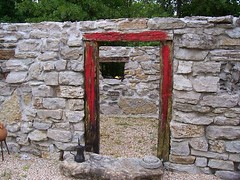
The three wooden lintels of the Passover
"Take a bunch of hyssop, dip it into the blood in the basin and put some of the blood on the top and on both sides of the doorframe..." (Exodus 12:22a)
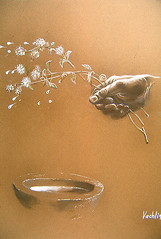
The three branches of hyssop in the Red Heifer Baptism
Something bothered me in this Scripture as I viewed a three-sided wooden doorway and tried to correlate it with the traditional four-sided cross so synonymous with Christianity.
This was not the first time I had attempted to synthesize the two symbols as I had preached on this typology at a sectional youth Christmas banquet years before. After completing Jesus the Baptist and arriving at the Unifying Theory of Baptisms, the synthesis became even more problematic.
I felt in my spirit that the connection was much more than just wood and the blood of a lamb. Suddenly, the symbols converged. I happened to catch sight of our church's logo and the thought came to my mind: "the cross that Jesus died on was a three-sided cross."
What? I had never heard of such a thing. However, the more I thought about the top and both sides of the Passover doorframes, the significance of the number three in baptisms, and the Trinity, the more I became convinced that the cross Jesus died upon was three-sided. It had to be!
"'I am the door: by me if any man enter in, he shall be saved, and shall go in and out, and find pasture.'" (John 10:9 KJV)When I came home from church, I performed a quick study on crosses. I learned that the earliest reference to the shape of the cross of Jesus comes from an ancient work known as the Epistle of Barnabas. In its ninth chapter, the cross of Jesus is likened to the uppercase Greek letter tau, which looks like an uppercase "T" in English.
From there, I learned that a "Tau cross" is called a crux commissa in Latin. But what really blew me away was that it is also referred to as an "Old Testament Cross." What did this mean?
Apparently it comes from the story of Moses and the Brazen Serpent:
"The LORD said to Moses, 'Make a snake and put it up on a pole; anyone who is bitten can look at it and live.' So Moses made a bronze snake and put it up on a pole. Then when anyone was bitten by a snake and looked at the bronze snake, he lived."(Numbers 28:8-9)That was it! There was the connection I was looking for. Jesus himself said that He was to fulfill this Scripture when He said:
"Just as Moses lifted up the snake in the desert, so the Son of Man must be lifted up, that everyone who believes in him may have eternal life."(John 3:14-15)The cross that Moses lifted up has been described as a three-sided cross. In my mind, a religious Jew familiar with the Old Testament Cross should look up and see the fulfillment of that cross in the cross of Jesus.
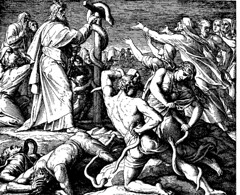
The three-sided Old Testament Cross
But the connections did not stop there. I learned that the Greek letter tau is equivalent phonetically with the Hebrew letter taw or tav.
This is significant for several reasons. One reason is that this letter is the mark that is placed on the foreheads of the righteous in Ezekiel 9:3-4:
"Now the glory of the God of Israel went up from above the cherubim, where it had been, and moved to the threshold of the temple. Then the LORD called to the man clothed in linen who had the writing kit at his side and said to him, 'Go throughout the city of Jerusalem and put a mark on the foreheads of those who grieve and lament over all the detestable things that are done in it.'"Another reason is that taw/tav is the last letter in the Hebrew alphabet. When one combines taw/tav with the first letter of the Hebrew alphabet, alef/aleph, you get the expression from "alef to tav". This Hebrew expression is synonymous with the Greek expression "Alpha and Omega."
"I am the Alpha and the Omega, the First and the Last, the Beginning and the End." (Revelation 22:13)One final reason for its significance I discovered was that it is the last letter in the trinitarian Hebrew word for "truth" - emet. "Truth" in Hebrew is formed by combining alef and the middle letter of the Hebrew alphabet mem with tav. Amazingly, the authors of the Talmud place special significance on this word calling it the "seal of God."
"Jesus answered, 'I am the way and the truth and the life. No one comes to the Father except through me.'" (John 14:6)
After discovering all these connections I have come full circle. I now see the connections between:
As I now understand the Cross of Jesus, it speaks messages from the Lord in two tongues simultaneously, in both Hebrew and Greek. Furthermore, it speaks both phonetically and visually. It is literally the tav of the law and of the prophets:
"'Do not think that I have come to abolish the Law or the Prophets; I have not come to abolish them but to fulfill them. I tell you the truth, until heaven and earth disappear, not the smallest letter, not the least stroke of a pen, will by any means disappear from the Law until everything is accomplished.'" (Matthew 5:17-18)In celebration of this seal, I offer a visual synthesis of all these ideas, the Crux of the Unifying Theory otherwise known as "The Cross of Emet:"

Reads in Hebrew from right-to-left in triangular motion "TRUTH"
"'Today in the town of David a Savior has been born to you; he is Christ the Lord. This will be a sign to you: You will find a baby wrapped in cloths and lying in a manger.'" (Luke 2:11-12)
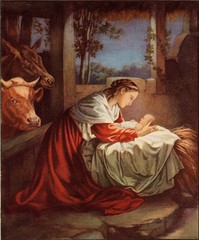
Notes:
The Cross of Emet was designed with several ideas in mind. First it uses the colors of the union on the traditional Christian flag, red and blue. Second, it depicts the three elements of The Unifying Theory: blood, water, and spirit using both the additive and subtractive primary colors. Spirit in this case is dually represented as golden yellow for glory and green for life (heb: nephesh). Third, it features the three-sided Tau cross, itself a sign of blood sacrifice. Fourth, its crossbeam (lat: patibulum) literally spells "Alef and Tav" or "Alpha and Omega" (this is where the titulus would have appeared in three languages reading "JESUS OF NAZARETH, THE KING OF THE JEWS"). Fifth, its upright post (lat: stipes) is balanced by the middle letter of the Hebrew alphabet mem. Lastly, a message from the Spirit of God is inscribed on its three-sides. It reads "truth."
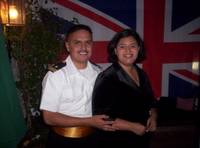


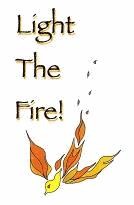

No comments:
Post a Comment